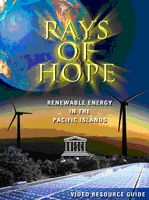 From the beginning, nature provided energy. In the Pacific islands – as elsewhere in the world – the use of nature’s energy enabled people to survive and flourish. Wind provided the power for sailing into and around the region. Biomass was used for cooking. Crops and fish were dried under the sun. Oil lamps and fires gave light.
From the beginning, nature provided energy. In the Pacific islands – as elsewhere in the world – the use of nature’s energy enabled people to survive and flourish. Wind provided the power for sailing into and around the region. Biomass was used for cooking. Crops and fish were dried under the sun. Oil lamps and fires gave light.
During the last hundred years, however, new sources of energy were introduced: petroleum-based products to fuel the growing numbers of cars, trucks and boats for transportation, fossil fuels to provide much-needed electricity. Increasing use of fossil fuels has had far-reaching consequences, including pollution, sea-level rise and climate change and a burdensome impact on recurrent household and national budgets.
Recognition of the negative implications of imported fossil fuels led in the late 1970s to a ‘first wave’ of projects in the Pacific for harnessing sources of renewable energy fuels, with mixed results. More recently, in the early 21st century, there is a new surge of interest and commitment, towards increasing the proportion of renewable energy use in the total primary energy supply.
UNESCO page - Read more...














